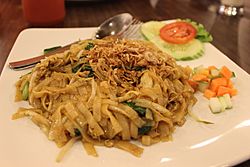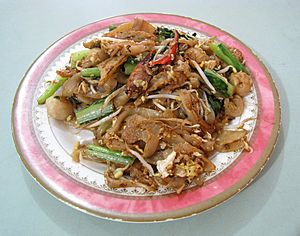Kwetiau goreng facts for kids

Kwetiau goreng in a restaurant in Indonesia served with acar pickles and fried shallot sprinkles
|
|
| Alternative names | Kuetiau goreng or Kwetiaw goreng |
|---|---|
| Course | Main course |
| Place of origin | Indonesia |
| Region or state | Nationwide |
| Serving temperature | Hot |
| Main ingredients | Fried flat noodles with chicken, meat, beef, prawn or crab |
Kwetiau goreng is a super popular Indonesian dish. The name means 'fried flat noodle' in Indonesian. It's a type of stir-fried noodle dish made with flat rice noodles.
These noodles are called kwetiau in Indonesia. They are stir-fried in hot oil with lots of yummy ingredients. These include garlic, onions, and different meats. You might find beef, chicken, fried prawns, crab, or even meatballs called bakso.
The dish also has fresh vegetables like Chinese cabbage, regular cabbages, and tomatoes. An egg is usually added too. A special ingredient is kecap manis, which is a sweet soy sauce. This gives the dish its unique sweet and savory taste.
You can find kwetiau goreng almost everywhere in Indonesia. It's sold by street vendors with their carts, known as warungs. You can also find it in fancy restaurants. It's a favorite meal for many Indonesians. Street food sellers often sell it alongside mie goreng (fried noodles) and nasi goreng (fried rice).
Indonesian kwetiau goreng often tastes a bit sweet because of the kecap manis. It can also be spicy if you add sambal chili sauce. Most of the time, it's made with halal chicken and beef. This means it's prepared in a way that follows Muslim rules. This is important because most people in Indonesia are Muslim.
Where Kwetiau Goreng Came From
Many Indonesian foods show a strong influence from Chinese cooking. Dishes like bakmi, mie ayam, pangsit, mie goreng, and kwetiau goreng are good examples. Kwetiau goreng comes from Chinese stir-fried flat rice noodles called shahe fen.
It's believed that Chinese immigrants brought this dish to Indonesia many centuries ago. Chinese people first arrived in Indonesia around the 7th century. By the 1600s, Chinese communities were growing along the coasts of Java and Sumatra. Over hundreds of years, Chinese and local Indonesian cultures mixed. This led to a blend of their foods.
Kwetiau goreng can be served with sweet soy sauce for a mild sweetness. Sometimes, it has crispy fried shallots called bawang goreng sprinkled on top. Adding sambal makes it spicy. You might also find krupuk (crispy crackers) on top for extra crunch. To make it suitable for Muslims, kwetiau goreng usually does not contain pork or lard.
Different Kinds of Kwetiau Goreng
Just like mie goreng, there are many ways to make kwetiau goreng. The ingredients can change, creating different versions. Here are some popular types:
- Kwetiau goreng sapi: This version uses beef.
- Kwetiau goreng ayam: This one is made with chicken.
- Kwetiau goreng seafood: This includes seafood like cuttlefish, prawns, and fish.
- Kwetiau goreng kepiting: This special type features crab.
If you like spicy food, you can try kwetiau goreng pedas. This version uses a lot of chili peppers! For those who prefer more veggies, kwetiau goreng sayuran focuses mainly on vegetables.
There are also other kwetiau dishes that are not stir-fried:
- Kwetiau kuah: This is kwetiau served in a soup.
- Kwetiau ayam: This is chicken kwetiau served in a soup.
- Kwetiau siram: Here, the flat rice noodles are boiled. Then, a thick soup or sauce is poured over them.
- Kwetiau bun: This is similar to kwetiau goreng but it's softer and moister. It has more water added during cooking.
Another interesting type is kwetiau goreng lenjer. This dish uses slices of pempek (a fishcake from Palembang). These slices are mixed with chicken, prawns, eggs, bean sprouts, and soy sauce.
In nearby Malaysia and Singapore, there's a similar dish called char kway teow. Sometimes, people there also call it kwetiau goreng or kuetiau goreng in Malay.


